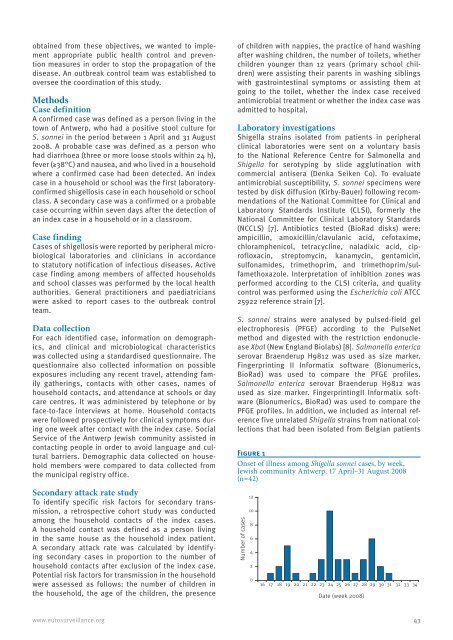Escherichia coli - Eurosurveillance
Escherichia coli - Eurosurveillance
Escherichia coli - Eurosurveillance
You also want an ePaper? Increase the reach of your titles
YUMPU automatically turns print PDFs into web optimized ePapers that Google loves.
obtained from these objectives, we wanted to implement<br />
appropriate public health control and prevention<br />
measures in order to stop the propagation of the<br />
disease. An outbreak control team was established to<br />
oversee the coordination of this study.<br />
Methods<br />
Case definition<br />
A confirmed case was defined as a person living in the<br />
town of Antwerp, who had a positive stool culture for<br />
S. sonnei in the period between 1 April and 31 August<br />
2008. A probable case was defined as a person who<br />
had diarrhoea (three or more loose stools within 24 h),<br />
fever (≥38°C) and nausea, and who lived in a household<br />
where a confirmed case had been detected. An index<br />
case in a household or school was the first laboratoryconfirmed<br />
shigellosis case in each household or school<br />
class. A secondary case was a confirmed or a probable<br />
case occurring within seven days after the detection of<br />
an index case in a household or in a classroom.<br />
Case finding<br />
Cases of shigellosis were reported by peripheral microbiological<br />
laboratories and clinicians in accordance<br />
to statutory notification of infectious diseases. Active<br />
case finding among members of affected households<br />
and school classes was performed by the local health<br />
authorities. General practitioners and paediatricians<br />
were asked to report cases to the outbreak control<br />
team.<br />
Data collection<br />
For each identified case, information on demographics,<br />
and clinical and microbiological characteristics<br />
was collected using a standardised questionnaire. The<br />
questionnaire also collected information on possible<br />
exposures including any recent travel, attending family<br />
gatherings, contacts with other cases, names of<br />
household contacts, and attendance at schools or day<br />
care centres. It was administered by telephone or by<br />
face-to-face interviews at home. Household contacts<br />
were followed prospectively for clinical symptoms during<br />
one week after contact with the index case. Social<br />
Service of the Antwerp Jewish community assisted in<br />
contacting people in order to avoid language and cultural<br />
barriers. Demographic data collected on household<br />
members were compared to data collected from<br />
the municipal registry office.<br />
Secondary attack rate study<br />
To identify specific risk factors for secondary transmission,<br />
a retrospective cohort study was conducted<br />
among the household contacts of the index cases.<br />
A household contact was defined as a person living<br />
in the same house as the household index patient.<br />
A secondary attack rate was calculated by identifying<br />
secondary cases in proportion to the number of<br />
household contacts after exclusion of the index case.<br />
Potential risk factors for transmission in the household<br />
were assessed as follows: the number of children in<br />
the household, the age of the children, the presence<br />
www.eurosurveillance.org<br />
of children with nappies, the practice of hand washing<br />
after washing children, the number of toilets, whether<br />
children younger than 12 years (primary school children)<br />
were assisting their parents in washing siblings<br />
with gastrointestinal symptoms or assisting them at<br />
going to the toilet, whether the index case received<br />
antimicrobial treatment or whether the index case was<br />
admitted to hospital.<br />
Laboratory investigations<br />
Shigella strains isolated from patients in peripheral<br />
clinical laboratories were sent on a voluntary basis<br />
to the National Reference Centre for Salmonella and<br />
Shigella for serotyping by slide agglutination with<br />
commercial antisera (Denka Seiken Co). To evaluate<br />
antimicrobial susceptibility, S. sonnei specimens were<br />
tested by disk diffusion (Kirby-Bauer) following recommendations<br />
of the National Committee for Clinical and<br />
Laboratory Standards Institute (CLSI), formerly the<br />
National Committee for Clinical Laboratory Standards<br />
(NCCLS) [7]. Antibiotics tested (BioRad disks) were:<br />
ampicillin, amoxicillin/clavulanic acid, cefotaxime,<br />
chloramphenicol, tetracycline, naladixic acid, ciprofloxacin,<br />
streptomycin, kanamycin, gentamicin,<br />
sulfonamides, trimethoprim, and trimethoprim/sulfamethoxazole.<br />
Interpretation of inhibition zones was<br />
performed according to the CLSI criteria, and quality<br />
control was performed using the <strong>Escherichia</strong> <strong>coli</strong> ATCC<br />
25922 reference strain [7].<br />
S. sonnei strains were analysed by pulsed-field gel<br />
electrophoresis (PFGE) according to the PulseNet<br />
method and digested with the restriction endonuclease<br />
XbaI (New England Biolabs) [8]. Salmonella enterica<br />
serovar Braenderup H9812 was used as size marker.<br />
Fingerprinting II Informatix software (Bionumerics,<br />
BioRad) was used to compare the PFGE profiles.<br />
Salmonella enterica serovar Braenderup H9812 was<br />
used as size marker. FingerprintingII Informatix software<br />
(Bionumerics, BioRad) was used to compare the<br />
PFGE profiles. In addition, we included as internal reference<br />
five unrelated Shigella strains from national collections<br />
that had been isolated from Belgian patients<br />
Figure 1<br />
Onset of illness among Shigella sonnei cases, by week,<br />
Jewish community Antwerp, 17 April–31 August 2008<br />
(n=42)<br />
Number of cases<br />
12<br />
10<br />
8<br />
6<br />
4<br />
2<br />
0<br />
16 17 18 19 20 21 22 23 24 25 26 27 28 29 30 31 32 33 34<br />
Date (week 2008)<br />
43

















